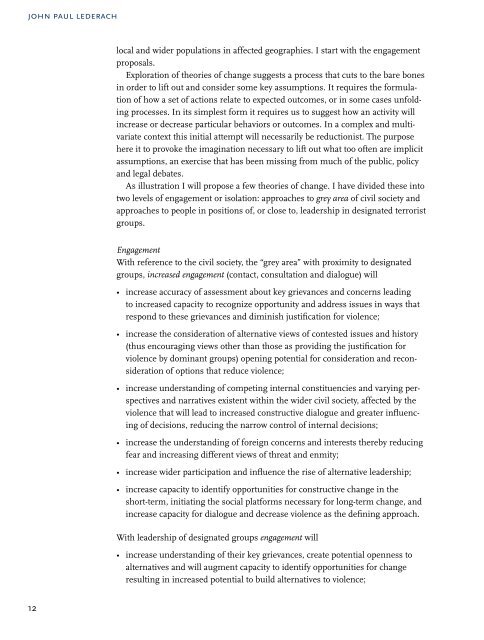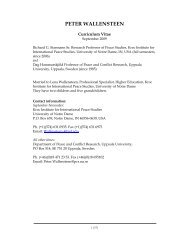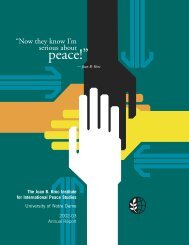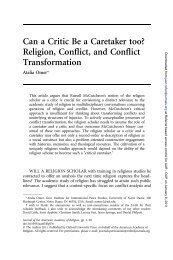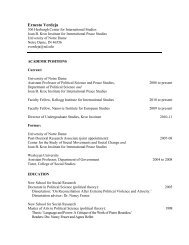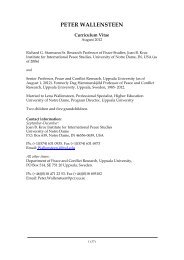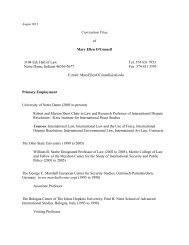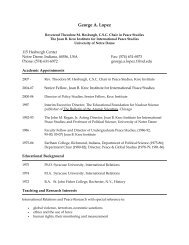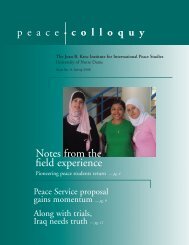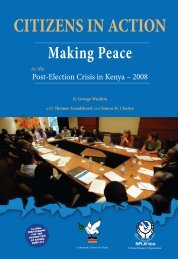Somalia: Creating Space for Fresh Approaches to Peacebuilding
Somalia: Creating Space for Fresh Approaches to Peacebuilding
Somalia: Creating Space for Fresh Approaches to Peacebuilding
Create successful ePaper yourself
Turn your PDF publications into a flip-book with our unique Google optimized e-Paper software.
john paul lederach<br />
12<br />
local and wider populations in affected geographies. I start with the engagement<br />
proposals.<br />
Exploration of theories of change suggests a process that cuts <strong>to</strong> the bare bones<br />
in order <strong>to</strong> lift out and consider some key assumptions. It requires the <strong>for</strong>mulation<br />
of how a set of actions relate <strong>to</strong> expected outcomes, or in some cases unfolding<br />
processes. In its simplest <strong>for</strong>m it requires us <strong>to</strong> suggest how an activity will<br />
increase or decrease particular behaviors or outcomes. In a complex and multivariate<br />
context this initial attempt will necessarily be reductionist. The purpose<br />
here it <strong>to</strong> provoke the imagination necessary <strong>to</strong> lift out what <strong>to</strong>o often are implicit<br />
assumptions, an exercise that has been missing from much of the public, policy<br />
and legal debates.<br />
As illustration I will propose a few theories of change. I have divided these in<strong>to</strong><br />
two levels of engagement or isolation: approaches <strong>to</strong> grey area of civil society and<br />
approaches <strong>to</strong> people in positions of, or close <strong>to</strong>, leadership in designated terrorist<br />
groups.<br />
Engagement<br />
With reference <strong>to</strong> the civil society, the “grey area” with proximity <strong>to</strong> designated<br />
groups, increased engagement (contact, consultation and dialogue) will<br />
• increase accuracy of assessment about key grievances and concerns leading<br />
<strong>to</strong> increased capacity <strong>to</strong> recognize opportunity and address issues in ways that<br />
respond <strong>to</strong> these grievances and diminish justification <strong>for</strong> violence;<br />
• increase the consideration of alternative views of contested issues and his<strong>to</strong>ry<br />
(thus encouraging views other than those as providing the justification <strong>for</strong><br />
violence by dominant groups) opening potential <strong>for</strong> consideration and reconsideration<br />
of options that reduce violence;<br />
• increase understanding of competing internal constituencies and varying perspectives<br />
and narratives existent within the wider civil society, affected by the<br />
violence that will lead <strong>to</strong> increased constructive dialogue and greater influencing<br />
of decisions, reducing the narrow control of internal decisions;<br />
• increase the understanding of <strong>for</strong>eign concerns and interests thereby reducing<br />
fear and increasing different views of threat and enmity;<br />
• increase wider participation and influence the rise of alternative leadership;<br />
• increase capacity <strong>to</strong> identify opportunities <strong>for</strong> constructive change in the<br />
short-term, initiating the social plat<strong>for</strong>ms necessary <strong>for</strong> long-term change, and<br />
increase capacity <strong>for</strong> dialogue and decrease violence as the defining approach.<br />
With leadership of designated groups engagement will<br />
• increase understanding of their key grievances, create potential openness <strong>to</strong><br />
alternatives and will augment capacity <strong>to</strong> identify opportunities <strong>for</strong> change<br />
resulting in increased potential <strong>to</strong> build alternatives <strong>to</strong> violence;


